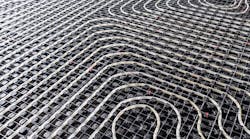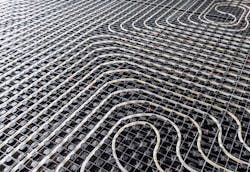Latest from Management
All About Indoor Air Quality
Sponsored
Last month, we continued a series of articles on my experiences as a former expert witness on hydronic heating systems. This is part three of that series.
Every contractor has his or her own way of doing business, and rarely do they have an opportunity to have that process peer reviewed to make certain that it isn’t a waste of time and does what they want it to do.
The Radiant Professionals Alliance (RPA) is in the process of developing a Best Practices manual, which will detail a lot of the technical side of the business, but probably won’t get into the business practices side of the equation.
On that subject, back when I was still actively practicing hydronics in the field, I had my methodology to discovery and presentation that we as a company had developed, and required our other system designers to adopt based on our positive experiences. This not to say these practices were the best, but they at least represented a beginning point for other contractors to consider.
Looking back at the mistakes that were made on the physical plant side of this example system, many problems could have been avoided if the contractor would have had numerous face-to-face meetings with the future homeowners to discuss their wishes, wants, needs, expectations, and final intentions as they pertain to finished flooring goods. I will caution you that some general contractors refuse to allow “their” clients to speak with any of the subcontractors.
When I run into this situation, I calmly explain the connected liabilities of having them make decisions without my input and back away from the table. If the general contractor won’t allow us to interface with the people who will be the final customer, I would rather not deal with them.
If the general contractors are concerned about price discussion sensitivities, I will agree to not discuss pricing in front of the customer — let me get back to you on that — then they do not have my best interests, or the consumers’ best interests, in mind, and I’d rather not have that type of business.
Most reputable general contractors would love to have your expertise at the table. It makes them look smarter. If they think they know your job better than you do, my suggestion would be to politely excuse yourself from this bid and move on. It’s not worth the stress to continue doing business with this type of person.
The discovery meeting
Discovery is a term that was presented to me by an architect. The name is self-explanatory. This is one of the first meetings between the homeowner and the comfort subcontractor.
This is where you discuss things like zoning preferences, heat sources, cooling needs (if any), indoor air-quality needs, etc. It is during this meeting that you have the opportunity to educate the consumer about things like recommended zoning considerations based on solar exposure, room use patterns, finish flooring conditions, etc.
This is where you explain to the consumer that the floors will actually only be perceptibly warm when it is extremely cold outside, and that while the floors, for the most part, will not be noticeably warm, they will be notably comfortable, regardless. Don’t oversell warm floors over the delivery of overall radiant comfort. And by all means, don’t limit your options to radiant floors only. Doing so will limit your ability in some situations to deliver good, high-quality radiant comfort.
If the owners demand high-resistance floor coverings in a bedroom setting, for example, then I direct the conversation away from radiant floors and guide them toward better alternatives. Those alternatives are radiant ceilings/walls and/or European-style panel radiators. I tell them that it doesn’t make sense to pay for these nice warm floors and then have them turn around and throw a huge, thick wool blanket on top of them and quash their output. Most consumers can visualize that scenario and will agree with your premise.
In your contractual proposal, it is recommended that when you make a critical suggestion pertaining to floor finishes and the need for insulation below or behind the radiant panel, that they initial their acknowledgement of your recommendations. This avoids the “You never told me that” scenario that pops up so often after the fact.
In the eyes of the legal system, if they acknowledge the recommendation with their initials, they understood the recommendation and if they decide to deviate, it takes the responsibility out of your pocket and puts it in theirs.
Managing the customers’ expectations is important in delivering the final product of comfort. And don’t forget to address the need for fresh air and the control of relative humidity. Include it as a part of your package, and if they decide to not take your recommendations to heart, then again, have them acknowledge it with their initials.
Going in to a new job pre-planning meeting, or discovery meeting as we are calling it, can do a number of advantageous things for you regardless of whether an architect or general contractor is included.
It is your opportunity to impress upon the consumer that you are an expert in this area, and that you have their best interests in mind. It also establishes the consumers’ expectations as they pertain to the performance of the energy and comfort system you are developing for them.
As you look at the initial plans, look at it as a “system” as a whole, and not just the individual pieces. Look for things like large-volume soaking bathtubs. If a 40-gal. water heater is shown on the plans, and you know the tub will require twice that volume to fill it, does it make sense to not mention that in your discovery process?
Here is your opportunity to do an upsell and add the domestic hot water heating capacity to the physical plant, guaranteeing full tubs of hot water and hot showers for most everyone.
Tune in next month as we continue to look at the discovery process and how it can help you become a better businessperson. In the meantime, join the RPA and help yourself become a better hydronics contractor.
All Mark Eatherton material on this website is protected by Copyright 2015. Any reuse of this material (print or electronic) must first have the expressed written permission of Mark Eatherton and CONTRACTOR Magazine. Please contact via email at: [email protected].
Mark Eatherton
Mark Eatherton material on this website is protected by Copyright 2017. Any reuse of this material (print or electronic) must first have the expressed written permission of Mark Eatherton and CONTRACTOR Magazine.



